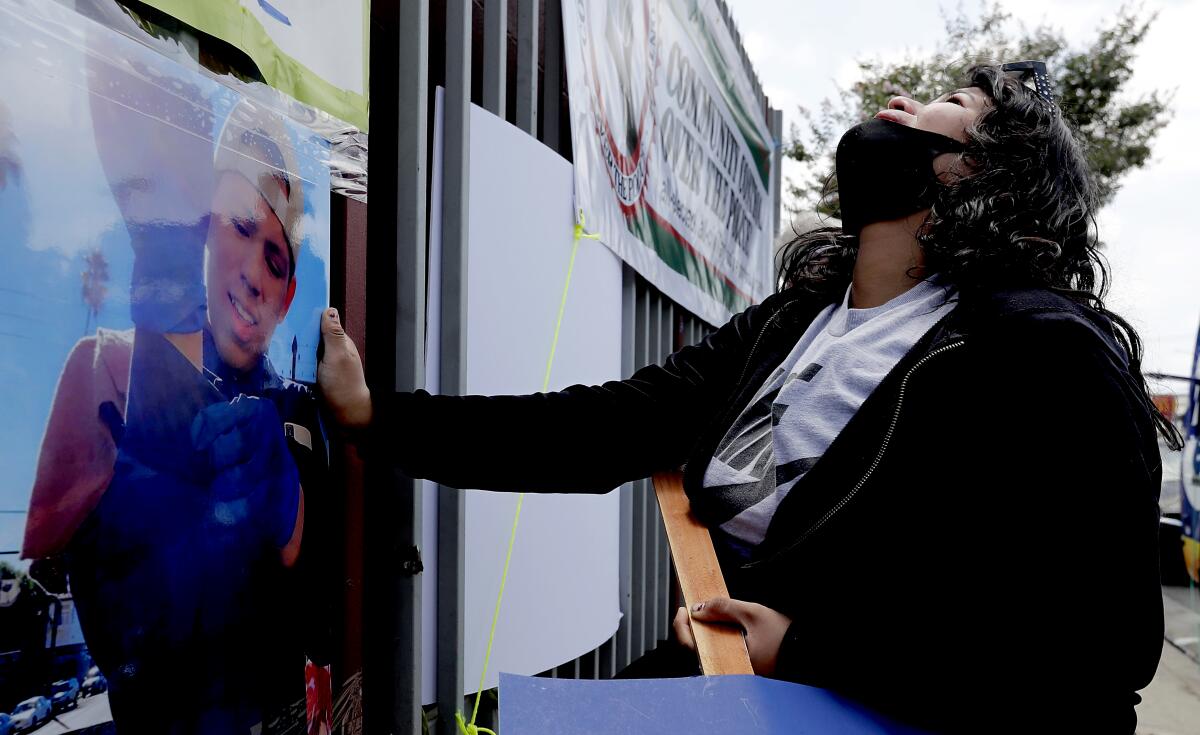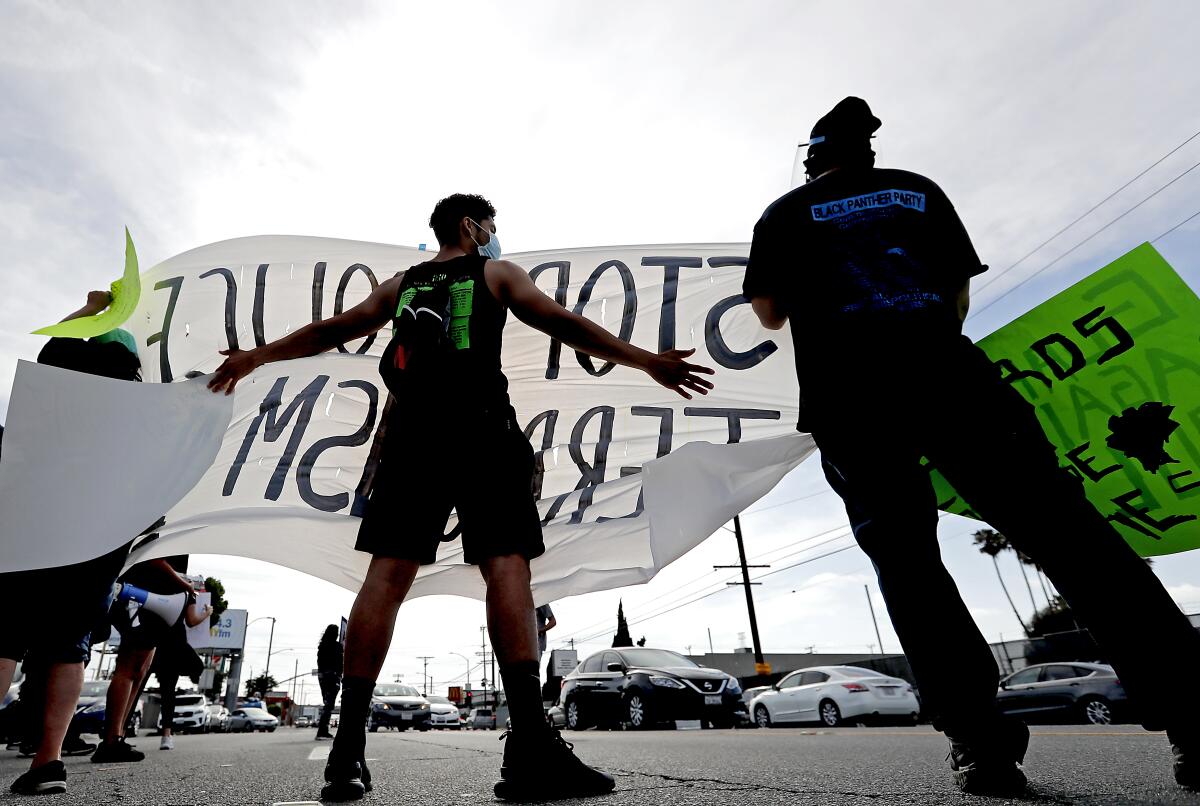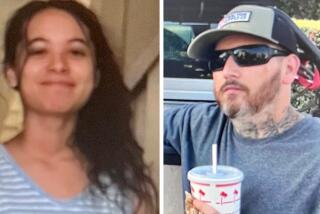Amid string of controversial shootings, L.A. County Sheriff’s Department moves slowly to deploy body cameras

- Share via
In a span of roughly 24 hours this week, Los Angeles County sheriff’s deputies shot and killed two men, raising questions about how the episodes escalated into deadly gunfire.
The only video to emerge after deputies on Wednesday shot Terron Boone, a 31-year-old Black man, in a Kern County community came from a home security camera that recorded audio of the incident. It’s unclear what footage, if any, investigators will be able to collect from the second scene in Gardena, where Andres Guardado, an 18-year-old Latino man working as a security guard, was fatally shot Thursday.
But no video was recorded by the deputies themselves.
After years of debates and then plans to distribute body cameras throughout the force, deputies still don’t have them. Nor do they have — or is the agency planning on getting — audio recorders or dash cameras for department vehicles.

Questions about the back-to-back shootings, which come amid nationwide unrest over police brutality and the killing in Minneapolis police custody of George Floyd, highlight how far the Sheriff’s Department trails other large law enforcement agencies in implementing what experts say is an important tool for accountability and transparency. The Los Angeles Police Department began deploying body cameras in 2015.
“Now is the time to do it,” said Mike Gennaco, a police practices expert who used to oversee such standards at the Sheriff’s Department. “It should’ve been done yesterday.”
Sheriff’s officials heading up the program say they agree. The program stalled for years over concerns about its costliness and policies for reviewing and releasing footage. More recently, implementation was tangled up in bureaucratic red tape.
“Everybody wants them,” said Cmdr. Chris Marks, pointing to deputies, members of the public and the courts. “The justice system wants them — everybody’s in agreement.”
The L.A. County Board of Supervisors set aside nearly $35 million to equip 5,200 deputies and security officers with the devices over the next two years.
The first batch is scheduled to roll out at Century station — a large and busy station with more than 200 deputies who patrol Walnut Park, Willowbrook and other areas — by October, said Sgt. Chris Meadows. After the new year, he said, four other stations, including Lakewood, Industry, West Hollywood and Lancaster, will get them. Two years from now, they should be deployed at 31 locations, including 24 patrol stations and seven specialized bureaus, Meadows said.
It’s not uncommon for deputies to wear their own body cameras, but the Sheriff’s Department does not track how many do so, and the rules for them are less strict. Once the Sheriff’s Department implements the program, personal body cameras will be prohibited, Marks said.
Studies are mixed about whether body cameras are a tool for reform and how well they work to prevent use of excessive force.
All four officers involved in Floyd’s death had them on and activated, said Minneapolis police spokesman John Elder. Many video recordings from high-profile incidents, such as the death of Floyd, whose neck was pinned by an officer’s knee for more than eight minutes, come from bystanders. Some of those videos conflict with official police accounts.
Gennaco said the devices are ineffective if they’re not coupled with appropriate policies.
“If you have a policy that is below standard, that does not match up with best practices, you might as well not have them,” he said.
In a report this week, the county’s Office of Inspector General said it was troubled by some measures developed by the Sheriff’s Department that appear to “strongly favor LASD employees over public transparency.”
For example, the report said, there are concerns supervisors and deputies have too much discretion in deciding when to turn the devices on and off and the policy prohibits random audits for the purpose of discovering misconduct.
Deputies will be able to review footage before giving a statement in an investigation, which Marks said was consistent with best practices put forth by an outside consultant hired by the county.
But Gennaco said that allowing such prior review could compromise investigations.
The detectives who shot and killed Boone were undercover and would not be supplied with body cameras.
“All those people will not have them because they’re just not in the field that much,” Meadows said.
![]A bullet went through the kitchen window of Joyce Chaney's apartment.](https://ca-times.brightspotcdn.com/dims4/default/a1c7b1f/2147483647/strip/true/crop/2400x1600+0+0/resize/1200x800!/quality/75/?url=https%3A%2F%2Fcalifornia-times-brightspot.s3.amazonaws.com%2F82%2Fb4%2Fe72fd27e46ffb9b6b93371feb400%2Fla-photos-1staff-560024-me-0618-terron-boone-dis-003.IK.JPG)
The fatal shooting of Boone, the half brother of Robert Fuller, a 24-year-old man found hanging from a tree in Palmdale last week, came as authorities were investigating allegations that he pistol-whipped, imprisoned and threatened a former girlfriend over a weeklong period. The woman found an opportunity to escape Monday and ran into a store to call 911, said Lt. Robert Westphal.
Two days later, undercover detectives trailed Boone to an apartment complex in Rosamond, about 20 miles north of Palmdale, where he exited the car’s passenger side and began shooting, striking the police vehicle’s hood and roof, Westphal said. Three detectives and a supervisor returned fire and shot him multiple times in the chest, killing him.
The death of Fuller and then Boone have stirred questions and heightened racial tensions in the Antelope Valley community.
Westphal said the lack of body camera video is not likely to hinder the investigation. And it’s rare nowadays that investigators aren’t able to collect some sort of video.
“It’s just another piece in the puzzle because videos don’t tell the whole story — they only tell a snapshot from a certain perspective. So it helps to piece things together, but it’s not by a long shot definitive,” Westphal said.
The shooting in Gardena Thursday raised still more questions. Two deputies from the Compton station observed Guardado outside a body shop before he “looked toward the deputies and produced a firearm,” the Sheriff’s Department said.
Guardado ran and the deputies gave chase, before one opened fire. But it’s unclear what prompted the gunfire. Investigators said a gun recovered at the scene was not registered and was loaded with a prohibited large-capacity magazine.
“We want to know why they killed him. What justification is there to shoot him seven times?” Guardado’s uncle Noe Abarca said at the scene Friday.
He kneeled on the sidewalk to light the Virgen de Guadalupe candles lined up in front of bouquets and a plush SpongeBob still in its plastic bag. Above him were signs that said: “Andres Guardado, 18 yr old, murdered by police,” “Justice for Andres,” “RIP Andres My Back was turned when they shot me.”
Sheriff’s officials said Guardado was struck in the upper torso and the coroner’s office had not completed an autopsy to determine how many times he was shot.
Lt. Charles Calderaro said investigators identified some buildings with cameras and were obtaining search warrants to get footage from the scene.
Abarca, who works nearby, said he arrived at the scene Friday morning and sheriffs had taken the security cameras and a digital video recorder from an auto body shop near where he was killed. Neither he nor the shop owner had seen the footage.
He said Guardado was friendly and funny, working two jobs as a security guard — the Sheriff’s Department said he did not have a security guard license — and was attending Los Angeles Trade Technical College to be a mechanic or electrician. He was considering joining the Army and had started working at Street Dynamic Autobody six to eight months ago.
He lived in Koreatown with his two siblings and parents. “His father and mom are destroyed in the house. There are no words to tell them right now.”
More to Read
Sign up for Essential California
The most important California stories and recommendations in your inbox every morning.
You may occasionally receive promotional content from the Los Angeles Times.












